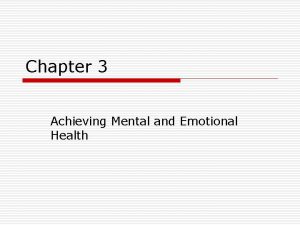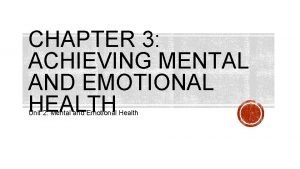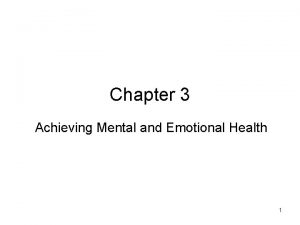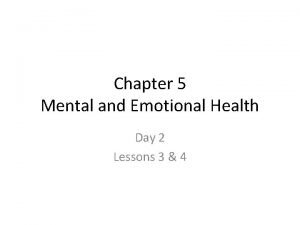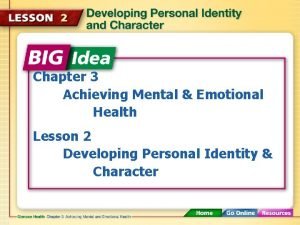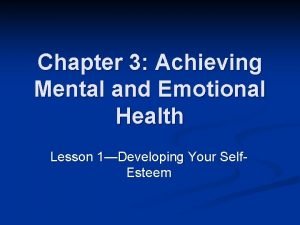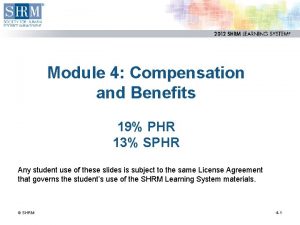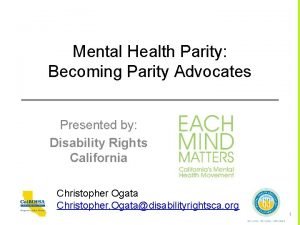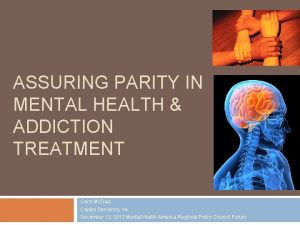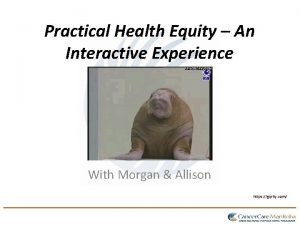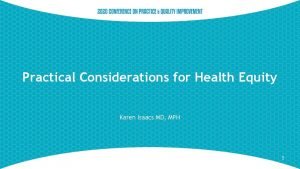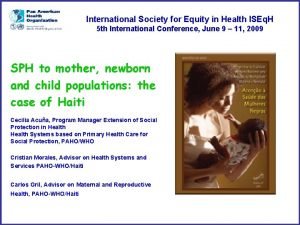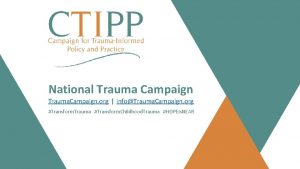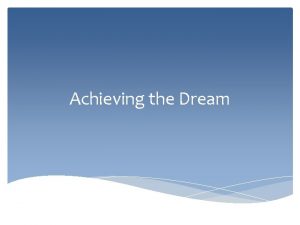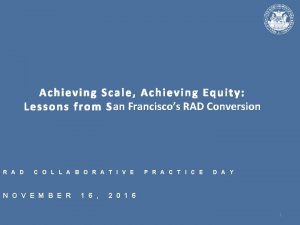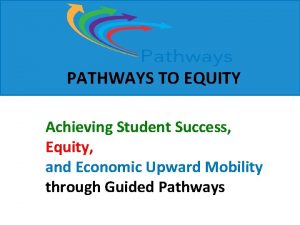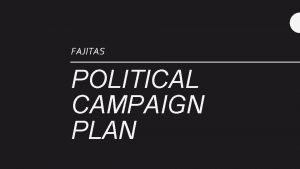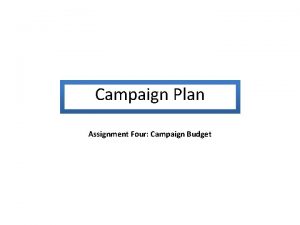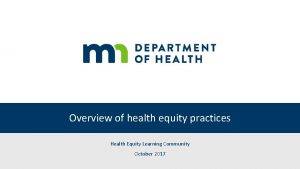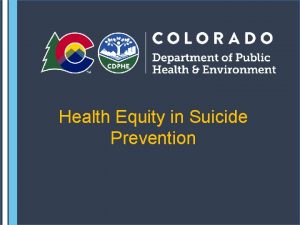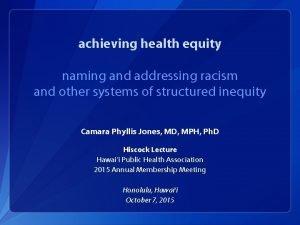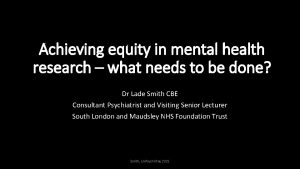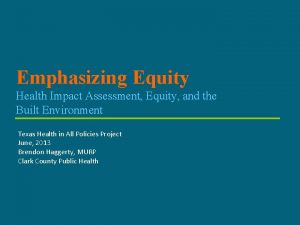Achieving Health Equity tools for a national campaign















































![What is [inequity]? A system of structuring opportunity and assigning value based on [fill What is [inequity]? A system of structuring opportunity and assigning value based on [fill](https://slidetodoc.com/presentation_image_h2/f2c1a6b0fe89e00917475090f24c1ea5/image-48.jpg)
![What is [inequity]? A system of structuring opportunity and assigning value based on [fill What is [inequity]? A system of structuring opportunity and assigning value based on [fill](https://slidetodoc.com/presentation_image_h2/f2c1a6b0fe89e00917475090f24c1ea5/image-49.jpg)








































- Slides: 89

Achieving Health Equity tools for a national campaign against racism Camara Phyllis Jones, MD, MPH, Ph. D 2016 Blanchard Memorial Lecture 49 th STFM Annual Spring Conference Society of Teachers of Family Medicine Minneapolis, Minnesota May 3, 2016

Disclosures I have no financial relationships to disclose.

Levels of health intervention Jones CP et al. J Health Care Poor Underserved 2009.

Jones CP et al. J Health Care Poor Underserved 2009.

Jones CP et al. J Health Care Poor Underserved 2009.

Jones CP et al. J Health Care Poor Underserved 2009.

Jones CP et al. J Health Care Poor Underserved 2009.

Jones CP et al. J Health Care Poor Underserved 2009.

Jones CP et al. J Health Care Poor Underserved 2009.

Jones CP et al. J Health Care Poor Underserved 2009.

Jones CP et al. J Health Care Poor Underserved 2009.

Jones CP et al. J Health Care Poor Underserved 2009.

Jones CP et al. J Health Care Poor Underserved 2009.

Jones CP et al. J Health Care Poor Underserved 2009.

Jones CP et al. J Health Care Poor Underserved 2009.

Addressing the social determinants of health Primary prevention Safety net programs and secondary prevention Jones CP et al. J Health Care Poor Underserved 2009. Medical care and tertiary prevention

But how do disparities arise? q Differences in the quality of care received within the health care system q Differences in access to health care, including preventive and curative services q Differences in life opportunities, exposures, and stresses that result in differences in underlying health status Phelan JC, Link BG, Tehranifar P. Social Conditions as Fundamental Causes of Health Inequalities. J Health Soc Behav 2010; 51(S): S 28 -S 40. Byrd WM, Clayton LA. An American Health Dilemma: Race, Medicine, and Health Care in the United States, 1900 -2000. New York, NY: Routledge, 2002. Smedley BD, Stith AY, Nelson AR (editors). Unequal Treatment: Confronting Racial and Ethnic Disparities in Health Care. Washington, DC: The National Academies Press, 2002.

Jones CP et al. J Health Care Poor Underserved 2009.

Jones CP et al. J Health Care Poor Underserved 2009.

Jones CP et al. J Health Care Poor Underserved 2009.

Jones CP et al. J Health Care Poor Underserved 2009.

Jones CP et al. J Health Care Poor Underserved 2009.

Jones CP et al. J Health Care Poor Underserved 2009.

Jones CP et al. J Health Care Poor Underserved 2009.

Differences in quality of care (ambulance slow or goes the wrong way) Jones CP et al. J Health Care Poor Underserved 2009. Differences in access to care Differences in exposures and opportunities

Addressing the social determinants of equity: Why are there differences in resources along the cliff face? Why are there differences in who is found at different parts of the cliff? Jones CP et al. J Health Care Poor Underserved 2009.

3 dimensions of health intervention Jones CP et al. J Health Care Poor Underserved 2009.

3 dimensions of health intervention Health services Jones CP et al. J Health Care Poor Underserved 2009.

3 dimensions of health intervention Health services Addressing social determinants of health Jones CP et al. J Health Care Poor Underserved 2009.

3 dimensions of health intervention Health services Addressing social determinants of health Addressing social determinants of equity Jones CP et al. J Health Care Poor Underserved 2009.

What is racism? A system Jones CP. Confronting Institutionalized Racism. Phylon 2003; 50(1 -2): 7 -22.

What is racism? A system of structuring opportunity and assigning value Jones CP. Confronting Institutionalized Racism. Phylon 2003; 50(1 -2): 7 -22.

What is racism? A system of structuring opportunity and assigning value based on the social interpretation of how one looks (which is what we call “race”) Jones CP. Confronting Institutionalized Racism. Phylon 2003; 50(1 -2): 7 -22.

What is racism? A system of structuring opportunity and assigning value based on the social interpretation of how one looks (which is what we call “race”), that § Unfairly disadvantages some individuals and communities Jones CP. Confronting Institutionalized Racism. Phylon 2003; 50(1 -2): 7 -22.

What is racism? A system of structuring opportunity and assigning value based on the social interpretation of how one looks (which is what we call “race”), that § § Unfairly disadvantages some individuals and communities Unfairly advantages other individuals and communities Jones CP. Confronting Institutionalized Racism. Phylon 2003; 50(1 -2): 7 -22.

What is racism? A system of structuring opportunity and assigning value based on the social interpretation of how one looks (which is what we call “race”), that § § § Unfairly disadvantages some individuals and communities Unfairly advantages other individuals and communities Saps the strength of the whole society through the waste of human resources Jones CP. Confronting Institutionalized Racism. Phylon 2003; 50(1 -2): 7 -22.

Levels of racism q q q Institutionalized Personally-mediated Internalized Jones CP. Levels of Racism: A Theoretic Framework and a Gardener’s Tale. Am J Public Health 2000; 90(8): 1212 -1215.

Institutionalized racism q Differential access to the goods, services, and opportunities of society, by “race” q Examples § § q Housing, education, employment, income Medical facilities Clean environment Information, resources, voice Explains the association between social class and “race” Jones CP. Levels of Racism: A Theoretic Framework and a Gardener’s Tale. Am J Public Health 2000; 90(8): 1212 -1215.

Personally-mediated racism q q Differential assumptions about the abilities, motives, and intents of others, by “race” Differential actions based on those assumptions Prejudice and discrimination Examples § § § Police brutality Physician disrespect Shopkeeper vigilance Waiter indifference Teacher devaluation Jones CP. Levels of Racism: A Theoretic Framework and a Gardener’s Tale. Am J Public Health 2000; 90(8): 1212 -1215.

Internalized racism q Acceptance by the stigmatized “races” of negative messages about our own abilities and intrinsic worth q Examples § § § q Self-devaluation “White man’s ice is colder” syndrome Resignation, helplessness, hopelessness Accepting limitations to our full humanity Jones CP. Levels of Racism: A Theoretic Framework and a Gardener’s Tale. Am J Public Health 2000; 90(8): 1212 -1215.

Levels of Racism: A Gardener’s Tale Jones CP. Levels of Racism: A Theoretic Framework and a Gardener’s Tale. Am J Public Health 2000; 90(8): 1212 -1215.

Who is the gardener? § Power to decide § Power to act § Control of resources q Dangerous when § Allied with one group § Not concerned with equity Jones CP. Levels of Racism: A Theoretic Framework and a Gardener’s Tale. Am J Public Health 2000; 90(8): 1212 -1215.

“How is racism operating here? ” q Identify mechanisms § Structures: the who? , what? , when? , and where? of decision-making § Policies: the written how? § Practices and norms: the unwritten how? § Values: the why? Jones CP. Confronting Institutionalized Racism. Phylon 2003; 50(1 -2): 7 -22.

“How is racism operating here? ” q Identify mechanisms § Structures: the who? , what? , when? , and where? of decision-making § Policies: the written how? § Practices and norms: the unwritten how? § Values: the why? Jones CP. Confronting Institutionalized Racism. Phylon 2003; 50(1 -2): 7 -22.

“How is racism operating here? ” q Identify mechanisms § Structures: the who? , what? , when? , and where? of decision-making § Policies: the written how? § Practices and norms: the unwritten how? § Values: the why? Jones CP. Confronting Institutionalized Racism. Phylon 2003; 50(1 -2): 7 -22.

“How is racism operating here? ” q Identify mechanisms § Structures: the who? , what? , when? , and where? of decision-making § Policies: the written how? § Practices and norms: the unwritten how? § Values: the why? Jones CP. Confronting Institutionalized Racism. Phylon 2003; 50(1 -2): 7 -22.

“How is racism operating here? ” q Identify mechanisms § Structures: the who? , what? , when? , and where? of decision-making § Policies: the written how? § Practices and norms: the unwritten how? § Values: the why? Jones CP. Confronting Institutionalized Racism. Phylon 2003; 50(1 -2): 7 -22.
![What is inequity A system of structuring opportunity and assigning value based on fill What is [inequity]? A system of structuring opportunity and assigning value based on [fill](https://slidetodoc.com/presentation_image_h2/f2c1a6b0fe89e00917475090f24c1ea5/image-48.jpg)
What is [inequity]? A system of structuring opportunity and assigning value based on [fill in the blank] Jones CP. Systems of Power, Axes of Inequity: Parallels, Intersections, Braiding the Strands. Medical Care 2014; 52(10)Suppl 3: S 71 -S 75.
![What is inequity A system of structuring opportunity and assigning value based on fill What is [inequity]? A system of structuring opportunity and assigning value based on [fill](https://slidetodoc.com/presentation_image_h2/f2c1a6b0fe89e00917475090f24c1ea5/image-49.jpg)
What is [inequity]? A system of structuring opportunity and assigning value based on [fill in the blank], that § § § Unfairly disadvantages some individuals and communities Unfairly advantages other individuals and communities Saps the strength of the whole society through the waste of human resources Jones CP. Systems of Power, Axes of Inequity: Parallels, Intersections, Braiding the Strands. Medical Care 2014; 52(10)Suppl 3: S 71 -S 75.

Many axes of inequity “Race” q Gender q Ethnicity q Labor roles and social class markers q Nationality, language, and legal status q Sexual orientation q Disability status q Geography q Religion q Incarceration history These are risk MARKERS q

What is health equity? q “Health equity” is assurance of the conditions for optimal health for all people q Achieving health equity requires § Valuing all individuals and populations equally § Recognizing and rectifying historical injustices § Providing resources according to need q Health disparities will be eliminated when health equity is achieved Jones CP. Systems of Power, Axes of Inequity: Parallels, Intersections, Braiding the Strands. Medical Care 2014; 52(10)Suppl 3: S 71 -S 75.

ICERD q International Convention on the Elimination of all forms of Racial Discrimination International anti-racism treaty adopted by the UN General Assembly in 1965 http: //www. ohchr. org/EN/Professional. Interest/Pages/CERD. aspx q q US signed in 1966 US ratified in 1994

Current status q 3 rd US report submitted to the UN Committee on the Elimination of Racial Discrimination (CERD) in 2013 http: //tbinternet. ohchr. org/_layouts/treatybodyexternal/Download. aspx? symboln o=CERD%2 f. C%2 f. USA%2 f 7 -9&Lang=en q q 82 parallel reports submitted by civil society organizations CERD considered at its 85 th session (13 -14 Aug 2014)

CERD Concluding Observations q 14 -page document (25 Sep 2014) available online http: //tbinternet. ohchr. org/_layouts/treatybodyexternal/Download. aspx? symboln o=CERD%2 f. C%2 f. USA%2 f. CO%2 f 7 -9&Lang=en q Concerns and recommendations § § § Racial profiling (paras 8 and 18) Residential segregation (para 13) Achievement gap in education (para 14) Differential access to health care (para 15) Disproportionate incarceration (para 20)

CERD Concluding Observations q 14 -page document (25 Sep 2014) available online http: //tbinternet. ohchr. org/_layouts/treatybodyexternal/Download. aspx? symboln o=CERD%2 f. C%2 f. USA%2 f. CO%2 f 7 -9&Lang=en q Concerns and recommendations § “The Committee recommends that the State party adopt a national action plan to combat structural racial discrimination” (para 25) § “The Committee recommends that the State party increase its efforts to raise public awareness and knowledge of the Convention throughout its territory” (para 32)

Japanese Lanterns: Colored perceptions



The colors we think we see are due to the lights by which we look. These colored lights distort and mask our true variability.

What is “race”? A social classification, not a biological descriptor. The social interpretation of how one looks in a “race”-conscious society.

Dual Reality: A restaurant saga

D O O R I looked up and noticed a sign. . .

OPEN

CLOSED Racism structures “Open/Closed” signs in our society.

D O O R It is difficult to recognize systems of inequity that privilege us. Those on the outside are very aware of the two-sided nature of the sign.

D O O R Is there really a two-sided sign? Hard to know, when only see “Open”. A privilege not to HAVE to know. Once DO know, can choose to act.

Life on a Conveyor Belt: Moving to action

Racism is most often passive

1. Name racism

2. Ask “How is racism operating here? ”

3. Organize and strategize to act

Camara Phyllis Jones, MD, MPH, Ph. D President American Public Health Association Senior Fellow Satcher Health Leadership Institute and Cardiovascular Research Institute Morehouse School of Medicine cpjones@msm. edu (404) 756 -5216 (404) 374 -3198 mobile


Please evaluate this presentation using the conference mobile app! Simply click on the "clipboard" icon on the presentation page.

Barriers to achieving health equity q A-historical culture § § § q Narrow focus on the individual § § q The present as disconnected from the past Current distribution of advantage/disadvantage as happenstance Systems and structures as givens and immutable Self-interest narrowly defined Limited sense of interdependence Limited sense of collective efficacy Systems and structures as invisible or irrelevant Myth of meritocracy § § § Role of hard work Denial of racism Two babies: Equal potential or equal opportunity?

Strategies for achieving health equity q To change opportunity structures § § Understand the importance of history Challenge the narrow focus on the individual Expose the “myth of meritocracy” Examine successful strategies from outside the US

Strategies for achieving health equity q To change opportunity structures § § § Understand the importance of history Challenge the narrow focus on the individual Expose the “myth of meritocracy” Examine successful strategies from outside the US Acknowledge existence of systems and structures View systems and structures as modifiable

Strategies for achieving health equity q To change opportunity structures § § § § Understand the importance of history Challenge the narrow focus on the individual Expose the “myth of meritocracy” Examine successful strategies from outside the US Acknowledge existence of systems and structures View systems and structures as modifiable Break down barriers to opportunity Build bridges to opportunity

Strategies for achieving health equity q To change opportunity structures § § § § § Understand the importance of history Challenge the narrow focus on the individual Expose the “myth of meritocracy” Examine successful strategies from outside the US Acknowledge existence of systems and structures View systems and structures as modifiable Break down barriers to opportunity Build bridges to opportunity Transform consumers to citizens Intervene on decision-making processes

Strategies for achieving health equity q To change opportunity structures § § § § § q Understand the importance of history Challenge the narrow focus on the individual Expose the “myth of meritocracy” Examine successful strategies from outside the US Acknowledge existence of systems and structures View systems and structures as modifiable Break down barriers to opportunity Build bridges to opportunity Transform consumers to citizens Intervene on decision-making processes To value all people equally § § Break out of bubbles to experience our common humanity Embrace ALL children as OUR children

American Public Health Association National Campaign Against Racism q q Active website: www. apha. org/racism Coming soon: Anti-Racism Collaborative with seven Collective Action Teams § § § § Communication and Dissemination Education and Development Global Matters Liaison and Partnership Organizational Excellence Policy and Legislation Science and Publications

Anti-Racism Collaborative Communication and Dissemination q Guiding questions § How can we support the naming of racism in all public and private spaces? § What tools and strategies are needed to start community conversations on racism? q Possible activities § Expand the APHA Webinar Series on Racism and Health § Convene Regional Town Halls on Anti-Racism and Health § Develop a toolbox of communication tools and strategies

Anti-Racism Collaborative Education and Development q Guiding questions § How can we support training around issues of “race”, racism, and anti-racism at educational institutions of all levels? § How does effective anti-racism curriculum look? q Possible activities § Convene anti-racism scholars and activists § Develop curricula for schools of public health and medicine § Establish an APHA Fellowship on Anti-Racism and Health

Anti-Racism Collaborative Global Matters q Guiding questions § How can we use the International Convention on the Elimination of all forms of Racial Discrimination (ICERD) to support anti-racism work in the United States? § What can we learn from anti-racism work in other nations? q Possible activities § Disseminate information on US obligations under ICERD § Engage with the US-Brazil Joint Action Plan to Eliminate Racism § Link with anti-racism scholars and activists globally

Anti-Racism Collaborative Liaison and Partnership q Guiding questions § What anti-racism work is happening at the community level? § What anti-racism work is happening in other sectors? § How can we create linkages? q Possible activities § Catalog and connect local anti-racism efforts § Outreach to partner organizations

Anti-Racism Collaborative Organizational Excellence q Guiding questions § How do we answer the question “How is racism operating here? ” in each of our settings? § How do we examine structures, policies, practices, norms, and values? q Possible activities § Develop tools to discern historical and contemporary mechanisms of institutionalized racism § Establish a National Advisory Committee on Anti-Racism and Health

Anti-Racism Collaborative Policy and Legislation q Guiding questions § What are current policy and legislative strategies to address and dismantle racism? § What new strategies should we propose? q Possible activities § Catalog anti-racism policies across jurisdictions § Propose new areas for legislation § Disseminate model legislation

Anti-Racism Collaborative Science and Publications q Guiding questions § What research has been done to examine the impacts of racism on the health and well-being of the nation and world? § What intervention strategies have been evaluated? § What are next steps? q Possible activities § Develop a compendium of measures of racism § Link anti-racism researchers in collaborative work § Develop a science of anti-racism

Camara Phyllis Jones, MD, MPH, Ph. D President American Public Health Association Senior Fellow Satcher Health Leadership Institute and Cardiovascular Research Institute Morehouse School of Medicine cpjones@msm. edu (404) 756 -5216 (404) 374 -3198 mobile
 The intentional use of unfriendly or offensive behavior
The intentional use of unfriendly or offensive behavior Chapter 3 achieving mental and emotional health
Chapter 3 achieving mental and emotional health Chapter 3 achieving mental and emotional health
Chapter 3 achieving mental and emotional health Achieving mental and emotional health
Achieving mental and emotional health Chapter 3 achieving mental and emotional health
Chapter 3 achieving mental and emotional health Chapter 15 achieving mental and emotional health answer key
Chapter 15 achieving mental and emotional health answer key Chapter 15 achieving mental and emotional health answer key
Chapter 15 achieving mental and emotional health answer key Chapter 3 achieving mental and emotional health
Chapter 3 achieving mental and emotional health Chapter 3 achieving mental and emotional health
Chapter 3 achieving mental and emotional health Chapter 3 achieving mental and emotional health
Chapter 3 achieving mental and emotional health Chapter 3 achieving mental and emotional health
Chapter 3 achieving mental and emotional health Chapter 15 achieving mental and emotional health
Chapter 15 achieving mental and emotional health National conference on agriculture for summer campaign
National conference on agriculture for summer campaign National conference for rabi campaign 2020
National conference for rabi campaign 2020 National programme for child health and welfare
National programme for child health and welfare Wageworks health equity
Wageworks health equity Mental health equity
Mental health equity Mental health equity
Mental health equity Health equity customer service
Health equity customer service Mental health equity
Mental health equity Health equity
Health equity Health equity
Health equity Myhealthequitycom
Myhealthequitycom International society for equity in health
International society for equity in health Health equity
Health equity Iso 22301 utbildning
Iso 22301 utbildning Novell typiska drag
Novell typiska drag Nationell inriktning för artificiell intelligens
Nationell inriktning för artificiell intelligens Ekologiskt fotavtryck
Ekologiskt fotavtryck Varför kallas perioden 1918-1939 för mellankrigstiden?
Varför kallas perioden 1918-1939 för mellankrigstiden? En lathund för arbete med kontinuitetshantering
En lathund för arbete med kontinuitetshantering Adressändring ideell förening
Adressändring ideell förening Tidböcker
Tidböcker Anatomi organ reproduksi
Anatomi organ reproduksi Förklara densitet för barn
Förklara densitet för barn Datorkunskap för nybörjare
Datorkunskap för nybörjare Boverket ka
Boverket ka Hur skriver man en tes
Hur skriver man en tes Autokratiskt ledarskap
Autokratiskt ledarskap Nyckelkompetenser för livslångt lärande
Nyckelkompetenser för livslångt lärande Påbyggnader för flakfordon
Påbyggnader för flakfordon Arkimedes princip formel
Arkimedes princip formel Offentlig förvaltning
Offentlig förvaltning Bo bergman jag fryser om dina händer
Bo bergman jag fryser om dina händer Presentera för publik crossboss
Presentera för publik crossboss Vad är ett minoritetsspråk
Vad är ett minoritetsspråk Kanaans land
Kanaans land Treserva lathund
Treserva lathund Luftstrupen för medicinare
Luftstrupen för medicinare Claes martinsson
Claes martinsson Cks
Cks Programskede byggprocessen
Programskede byggprocessen Bra mat för unga idrottare
Bra mat för unga idrottare Verktyg för automatisering av utbetalningar
Verktyg för automatisering av utbetalningar Rutin för avvikelsehantering
Rutin för avvikelsehantering Smärtskolan kunskap för livet
Smärtskolan kunskap för livet Ministerstyre för och nackdelar
Ministerstyre för och nackdelar Tack för att ni har lyssnat
Tack för att ni har lyssnat Mall för referat
Mall för referat Redogör för vad psykologi är
Redogör för vad psykologi är Stål för stötfångarsystem
Stål för stötfångarsystem Tack för att ni har lyssnat
Tack för att ni har lyssnat Borra hål för knoppar
Borra hål för knoppar Orubbliga rättigheter
Orubbliga rättigheter Beräkna standardavvikelse
Beräkna standardavvikelse Tack för att ni har lyssnat
Tack för att ni har lyssnat Steg för steg rita
Steg för steg rita Verksamhetsanalys exempel
Verksamhetsanalys exempel Tobinskatten för och nackdelar
Tobinskatten för och nackdelar Toppslätskivling dos
Toppslätskivling dos Datumr
Datumr Egg för emanuel
Egg för emanuel Elektronik för barn
Elektronik för barn Plagg i rom
Plagg i rom Strategi för svensk viltförvaltning
Strategi för svensk viltförvaltning Kung dog 1611
Kung dog 1611 Ellika andolf
Ellika andolf Ro i rom pax
Ro i rom pax Tack för att ni lyssnade
Tack för att ni lyssnade Vilket tal pekar pilen på
Vilket tal pekar pilen på Upprepningar i prosa
Upprepningar i prosa Inköpsprocessen steg för steg
Inköpsprocessen steg för steg Rbk-mätning
Rbk-mätning Ledarskapsteorier
Ledarskapsteorier Exspektans eller expektans
Exspektans eller expektans Myndigheten för delaktighet
Myndigheten för delaktighet Trög för kemist
Trög för kemist Tillitsbaserad ledning
Tillitsbaserad ledning Läkarutlåtande för livränta
Läkarutlåtande för livränta Karttecken kraftledning
Karttecken kraftledning

